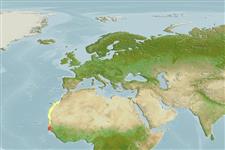Classification / Names
Common names from other countries
Main reference
Size / Weight / Age
Max length : 81.0 cm TL male/unsexed; (Ref. 1371); common length : 42.0 cm TL male/unsexed; (Ref. 1371)
Environment
Marine; demersal; oceanodromous (Ref. 51243); depth range 15 - 800 m (Ref. 58452), usually 100 - 600 m (Ref. 58452)
Climate / Range
Tropical, preferred 20°C (Ref. 107945); 33°N - 12°N, 19°W - 8°W (Ref. 58452)
Distribution
Short description
Dorsal
spines
(total): 1;
Dorsal
soft rays
(total): 47-51. Head rather long. Pectoral fin tips usually reaching origin of anal fin. Caudal fin usually truncate, progressively becoming concave with growth. Color is steel gray to blackish on back, silvery white on sides and belly.
IUCN Red List Status (Ref. 115185)
Threat to humans
Harmless
Human uses
Fisheries: highly commercial
More information
ReferencesAquacultureAquaculture profileStrainsGeneticsAllele frequenciesHeritabilityDiseasesProcessingMass conversion
Tools
Special reports
Download XML
Internet sources
Estimates of some properties based on models
Phylogenetic diversity index
PD50 = 0.5000 many relatives (e.g. carps) 0.5 - 2.0 few relatives (e.g. lungfishes)
Trophic Level
4.5 ±0.80 se; Based on food items.
Resilience
Low, minimum population doubling time 4.5 - 14 years (K=0.07-0.17)
Vulnerability
High to very high vulnerability (69 of 100)
Price category
